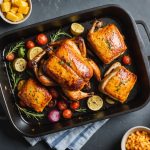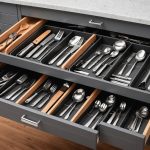Choosing the right material for non-stick roasting pans can transform your cooking experience. With options like ceramic, stainless steel, and silicone, understanding their unique properties helps you achieve hassle-free results. Each material offers distinct benefits, from superior heat distribution to easy cleanup. Whether you're an amateur cook or a seasoned chef, this guide will help you select the ultimate roasting pan that suits your culinary needs, making mealtime simpler and more enjoyable. Discover which material reigns supreme for your kitchen adventures!
Overview of Non-Stick Roasting Pan Materials
Exploring the world of non-stick roasting pan materials can help you make informed decisions.
This might interest you : Discover the unique flavor of maille mustard today!
Common Non-Stick Materials
When considering non-stick roasting pan materials, it's essential to understand the different types of non-stick coatings available. Teflon, known for its smooth surface, is a popular choice for its affordability and ease of cleaning. However, it may release fumes at high temperatures. Ceramic coatings provide a more environmentally-friendly option, offering durability without harmful chemicals. They can withstand higher temperatures, making them suitable for oven use. Anodized aluminum is another robust option, combining the benefits of aluminum with a non-stick surface.
Comparison of Teflon, Ceramic, and Anodized Aluminum
- Teflon: Affordable, easy to clean, but sensitive to high heat.
- Ceramic: Eco-friendly, durable, and heat-resistant.
- Anodized Aluminum: Sturdy, even heat distribution, and long-lasting.
Alternative Materials and Their Benefits
Beyond these, alternative non-stick roasting pan materials like stainless steel with non-stick coatings are gaining popularity. They offer a balance of durability and non-stick convenience. Other options include cast iron with enamel coatings, providing excellent heat retention and a naturally non-stick surface when properly seasoned.
Topic to read : Essential Tips for Selecting a Heat-Resistant Soup Ladle That Won”t Warp or Melt
Understanding these materials and coatings can guide you in choosing the best roasting pan for your culinary needs.
Pros and Cons of Non-Stick Materials
Exploring the advantages and disadvantages of non-stick pans is crucial for informed decision-making.
Benefits of Non-Stick Roasting Pans
Using non-stick roasting pans offers several benefits. Their ease of cleaning is a significant advantage, reducing the time and effort needed after cooking. Non-stick surfaces require less oil, promoting healthier cooking. They also provide excellent food release, ensuring your dishes remain intact and presentable. Additionally, non-stick pans heat up quickly and distribute heat evenly, enhancing cooking performance.
Potential Drawbacks and Safety Concerns
Despite the advantages, there are potential drawbacks and safety concerns associated with non-stick roasting pans. Teflon coatings, for example, can release fumes if overheated, raising safety issues. Some non-stick materials may wear over time, reducing their effectiveness. It's essential to avoid using metal utensils, which can scratch and damage the surface.
Performance Analysis of Different Materials
A performance analysis of different non-stick materials reveals varied results. Ceramic coatings excel in durability and heat resistance but may require more careful handling. Anodized aluminum offers even heat distribution and longevity, though it might be heavier. Understanding the performance differences helps in selecting the best pan for your needs.
- Teflon: Quick heating, but temperature-sensitive
- Ceramic: Durable, eco-friendly, careful use needed
- Anodized Aluminum: Even heat, sturdy, heavier
By weighing these pros and cons, you can make an informed choice.
Maintenance Tips for Non-Stick Roasting Pans
Proper care extends the life of your non-stick pans.
Best Practices for Cleaning Non-Stick Surfaces
Caring for non-stick pans is crucial to maintain their performance. Always allow the pan to cool before cleaning to prevent warping. Use warm, soapy water and a soft sponge to gently clean the surface. Avoid abrasive scrubbers, which can damage the coating.
Recommended Tools and Products for Maintenance
To ensure longevity, use silicone or wooden utensils when cooking. These materials are gentle on non-stick surfaces. For stubborn residues, a mixture of baking soda and water can be an effective cleaner. Consider investing in a non-stick pan maintenance kit, which typically includes specialized cleaning solutions and soft brushes.
Common Mistakes to Avoid When Using Non-Stick Pans
Avoiding certain practices is essential in caring for non-stick pans. Refrain from using metal utensils, which can scratch the surface. Never use high heat settings, as they can degrade the non-stick coating. Additionally, stacking pans without protection can lead to scratches. Use pan protectors or towels between stacked pans.
- Use gentle cleaning tools
- Avoid high heat
- Protect surfaces when storing
By following these tips, you can extend the life of your non-stick roasting pans and ensure they remain a staple in your kitchen.
Buying Guide for Non-Stick Roasting Pans
Selecting the right roasting pan can enhance your cooking experience.
Key Features to Consider
When learning how to choose non-stick pans, focus on several essential features. Size and shape are crucial, depending on your cooking needs and oven space. Opt for a pan with sturdy handles for safe maneuvering. Check the heat resistance to ensure it can withstand your cooking temperatures. Consider the compatibility with your cooktop, especially if you use induction.
Price Range and Value Assessment
Understanding the price range helps in evaluating value. Non-stick roasting pans can range from budget-friendly to premium models. Assess the durability and longevity to determine if the cost aligns with the quality. Investing in a slightly more expensive pan might offer better performance and lifespan, providing greater value.
Recommendations for Brands and Models
Choosing reputable brands ensures quality and satisfaction. Brands like Calphalon, Cuisinart, and All-Clad are renowned for their non-stick roasting pans. They offer a variety of models catering to different needs and budgets.
- Calphalon: Known for durability and even heating
- Cuisinart: Offers eco-friendly ceramic options
- All-Clad: Premium quality and excellent heat distribution
By considering these factors, you can make an informed decision when purchasing a non-stick roasting pan.
Safety Considerations with Non-Stick Materials
Understanding the safety of non-stick cookware is essential for informed use.
Health Implications of Non-Stick Coatings
The safety of non-stick cookware often concerns the release of chemicals at high temperatures. Teflon, a common non-stick coating, can emit fumes if overheated, potentially impacting health. It's crucial to maintain cooking temperatures below 500°F to prevent these emissions. Ceramic coatings, however, are generally free from harmful chemicals, offering a safer alternative.
Understanding Chemical Composition of Materials
The chemical makeup of non-stick coatings varies. Teflon contains PTFE, which is stable under normal cooking conditions but can degrade at extreme heats. Ceramic coatings are made from inorganic materials, reducing chemical concerns. Anodized aluminum combines aluminum's properties with a non-stick layer, offering a balance of safety and performance.
Guidelines for Safe Usage of Non-Stick Pans
Adhering to safety guidelines ensures the longevity and safety of non-stick pans. Always preheat pans on low or medium heat and avoid using metal utensils that can scratch surfaces. Regularly inspect the pan for signs of wear or damage.
- Use low to medium heat
- Avoid metal utensils
- Inspect regularly for damage
By following these practices, the safety of non-stick cookware can be maintained effectively.
Recipes for Non-Stick Roasting Pans
Unlock the culinary potential of your non-stick roasting pans with these flavorful recipes.
Simple and Effective Recipes
Cooking with non-stick pans can transform ordinary dishes into extraordinary meals. Consider a herb-crusted chicken: coat chicken breasts with a mix of herbs, breadcrumbs, and Parmesan cheese. Bake in a preheated non-stick roasting pan at 375°F for 25 minutes. The non-stick surface ensures a crispy exterior without sticking, enhancing both flavor and presentation.
Cooking Techniques
Maximize the benefits of non-stick roasting pans by employing techniques like searing and deglazing. Sear meats at medium-high heat to lock in juices, then deglaze with broth or wine to create a rich sauce. This method utilizes the pan's even heat distribution, ensuring a perfect cook every time.
Tips for Flavor Enhancement
Enhance flavors by incorporating fresh herbs and spices. Sprinkle rosemary and thyme over roasted vegetables for an aromatic touch. Use a bulleted list to remember key tips:
- Preheat the pan for even cooking
- Use minimal oil to maintain non-stick properties
- Garnish with fresh herbs for added flavor
These tips and recipes showcase the versatility of non-stick roasting pans, encouraging you to explore and experiment in the kitchen.
Visual Comparisons of Non-Stick Materials
Exploring the visual differences among various non-stick materials aids in making informed choices.
Infographic or Charts
Understanding non-stick material comparison can be greatly enhanced through visual aids like infographics or charts. These tools provide a clear, concise overview of how different non-stick materials perform under various conditions. For instance, a chart might show the heat resistance, durability, and eco-friendliness of Teflon, Ceramic, and Anodized Aluminum side by side.
Visual Representation of Cooking Results
Visuals can also depict cooking results with various pans, illustrating how different non-stick materials affect food presentation. A visual comparison might highlight the crispiness of a seared chicken breast or the even browning of roasted vegetables when using a particular pan.
Side-by-Side Product Images and Ratings
Using side-by-side images of products can further enhance a non-stick material comparison. These visuals, accompanied by ratings, allow you to quickly assess the aesthetic and functional qualities of each option. Consider a bulleted list for clarity:
- Teflon: Smooth finish, affordable
- Ceramic: Eco-friendly, vibrant colors
- Anodized Aluminum: Sturdy, sleek design
By leveraging these visual aids, readers can better understand the benefits and limitations of each non-stick material in a practical context.
Consumer Reviews and Recommendations
Exploring user experiences and expert insights on non-stick roasting pans
Summary of Consumer Feedback
Consumer reviews for non-stick roasting pans reveal varied experiences. Many users appreciate the ease of cleaning and even heat distribution. A common theme is the preference for ceramic coatings due to their eco-friendly nature and durability. Users often highlight brands like Calphalon and Cuisinart for their reliable performance.
Insights from Culinary Experts and Bloggers
Culinary experts and bloggers frequently discuss the importance of choosing the right non-stick roasting pan. According to Chef Julia, "Selecting a pan with a sturdy build and effective non-stick coating can elevate your cooking." Bloggers often recommend anodized aluminum for its heat retention and sturdiness, noting its effectiveness in professional kitchens.
Highlighting Standout Products
Based on performance, several standout non-stick roasting pans emerge from user reviews and expert insights.
- Calphalon: Praised for its durability and even cooking
- Cuisinart: Renowned for eco-friendly ceramic options
- All-Clad: Valued for premium quality and heat distribution
These products consistently receive high marks for their non-stick capabilities and overall functionality, making them popular choices among both home cooks and professionals.
Conclusion on Choosing Non-Stick Roasting Pans
Final thoughts on non-stick pans and decision making for cookware.
When selecting a non-stick roasting pan, several key considerations can guide your choice. The material plays a crucial role in performance and longevity. Teflon, Ceramic, and Anodized Aluminum each offer distinct advantages, such as heat resistance and eco-friendliness.
Size and shape are also vital, impacting how well the pan fits in your oven and accommodates different recipes. Consider the compatibility with your cooktop, especially if you use induction.
Experimenting with different materials can enhance your cooking experience. Trying various non-stick pans allows you to discover which suits your cooking style best. Whether you prefer the affordability of Teflon or the durability of Ceramic, each option has unique benefits.
Final Recommendations
- Teflon: Ideal for budget-conscious cooks seeking easy cleaning.
- Ceramic: Perfect for those prioritizing eco-friendly options.
- Anodized Aluminum: Best for professionals needing robust performance.
User preferences and cooking styles ultimately determine the best choice. By understanding these factors, you can make an informed decision, ensuring your non-stick roasting pan meets your culinary needs and enhances your kitchen adventures.













